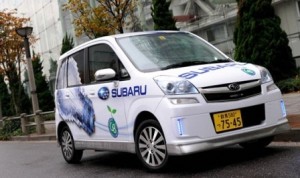Subaru is in the midst of an ambitious new electric vehicle program, but it won’t turn up in the United States any time soon. Instead, the automaker plans to prove its products in Japan where it plans to put more than 170 pure EVs into the fleets of local government and utility companies. The fleet program is the first step in a wider program that Subaru hopes to roll out in a couple of years.
The new Subaru EVs are based on the four seat, Stella minivan, according to Takashi Suzuki, one of the managers responsible for Subaru’s battery-electric-vehicle program.
Subaru’s EV program began in 2006 when it introduced the R1e, a two-seater developed with the help of TEPCO, the Tokyo Electric Power Co., which has become a major patron of the development of EVs in Japan. The 40 EVs built collected more than 340,000 kilometers of real-world driving experience during the three-year experiment.
The initial experiment underscored some of the limitations. The range of the R1e was 80 kilometers. The new Stella, however, can go 90 kilometers per charge and is a larger vehicle weighing 1,100 kilograms or 2,400 pounds versus the 920 kilograms or roughly 2,000 pounds for the R1e, said Suzuki. He noted that given the size difference between the two electrical vehicles there has been a significant increase in battery efficiency with the Stella.
But the range is still limited, leaving EVs best suited for the city driving and short commutes.
“I don’t think EVS will replace all the vehicles on the road,” noted Suzuki. “For mid- to long-range driving, gasoline and diesel will probably remain the best. We have to think about what the best role is for the EV.”
Suzuki said another issue is charging. Subaru’s research indicates that buyers want an ordinary plug for recharging the vehicle. In fact, the plug is something of deal breaker for many consumers. Hence, the Stella’s plug can plug into an ordinary 100-volt outlet and comes with adapter for 200-volt plug if one happens to be available.
The vehicle plug itself on the Stella uses the five-prong plug , also used by other Japanese automakers, and which the Society of Automotive Engineers is recommending become standard across the industry, starting in 2011.
The interest in the Stella is growing, added Suzuki, noting that people from all over Japan have inquired about the vehicle, who has developed a short test-drive around Subaru’s headquarter s in Tokyo. Interest in EVs generally has been growing in Japan but they still cost three times more than a conventional car because of the cost of the battery.
The preliminary feedback from the Stella test is excellent. Drivers are especially impressed with the acceleration and the speed. The acceleration is as good or better than in a conventional vehicle with a gasoline engine.
However, Subaru plans to proceed carefully with the development of EVs. It wants to see the results from the first tests of the Stella before offering an EV to more potential buyers in Japan. The study could take up to three years, he added. “Then we will talk about going overseas,” Suzuki said.

